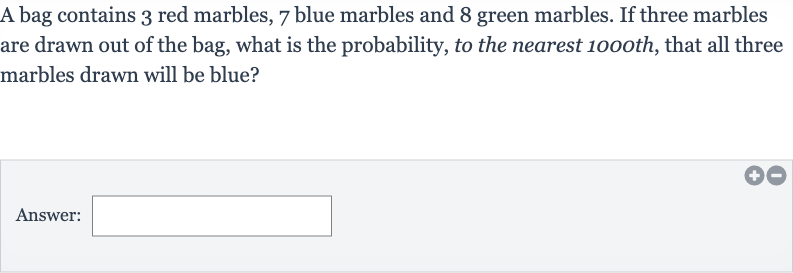AI tutor
Welcome to Bytelearn!
Let’s check out your problem:

A bag contains red marbles, blue marbles and green marbles. If two marbles are drawn out of the bag, what is the probability, to the nearest oth of a percent, that both marbles drawn will be green?Answer:
Full solution
Q. A bag contains red marbles, blue marbles and green marbles. If two marbles are drawn out of the bag, what is the probability, to the nearest oth of a percent, that both marbles drawn will be green?Answer:
- Determine total number of marbles: Determine the total number of marbles in the bag.The bag contains red marbles, blue marbles, and green marbles. To find the total, add these numbers together.Total marbles = red + blue + greenTotal marbles =
- Calculate probability of drawing green marble: Calculate the probability of drawing one green marble. Since there are green marbles and total marbles, the probability of drawing one green marble on the first draw is: Probability of first green marble Number of green marbles Total number of marbles Probability of first green marble
- Calculate probability of second green marble: Calculate the probability of drawing a second green marble after one has already been drawn.After one green marble has been drawn, there is now green marble left and the total number of marbles in the bag is . The probability of drawing the second green marble is:Probability of second green marble Number of remaining green marbles New total number of marblesProbability of second green marble
- Calculate combined probability: Calculate the combined probability of both events happening.To find the probability of both events happening (drawing two green marbles in a row), multiply the probabilities of each individual event.Combined probability = Probability of first green marble Probability of second green marbleCombined probability = Combined probability =
- Simplify combined probability: Simplify the combined probability.Simplify the fraction to its lowest terms.Combined probability =
- Convert probability to percentage: Convert the probability to a percentage.To convert the probability to a percentage, multiply by .Percentage probability = Combined probability Percentage probability =
- Calculate percentage to nearest tenth: Calculate the percentage to the nearest tenth of a percent.Perform the division to find the percentage.Percentage probability To the nearest tenth of a percent, this is approximately .
More problems from Percent error: word problems
QuestionGet tutor help
QuestionGet tutor help
QuestionGet tutor help
QuestionGet tutor help
QuestionGet tutor help
